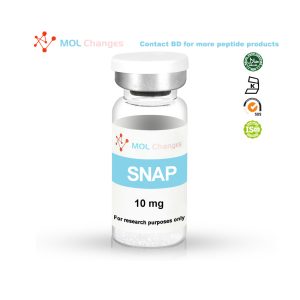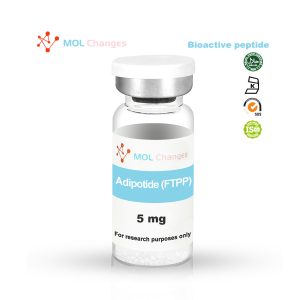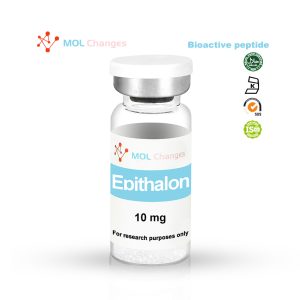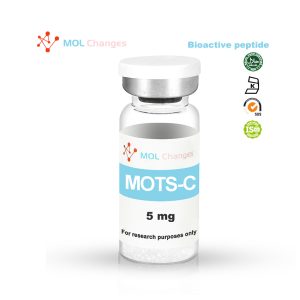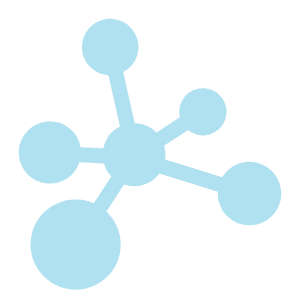
製品情報ナビゲーション
GHK-Cu構造
- シーケンス:Gly-His-Lys.Cu.xHAc
- CAS番号89030-95-5
- 分子式:C14H23CuN6O4
- 分子量: 340.384 g/mol
GHK-Cuとは?
GHK-Cuは、ヒト血漿から初めて単離された天然由来のペプチドである。その後、尿や唾液からも発見されている。GHK-Cuの研究により、この短いペプチドが創傷治癒と免疫機能に大きな効果があることがわかった。GHK-Cuには抗老化作用があり、フリーラジカルによる損傷を抑制し、タンパク質合成を増加させ、細菌と闘い、皮膚と皮膚線維芽細胞の健康を増進させることがわかっている。
GHK-Cuリサーチ
1.GHK-Cuと皮膚の治癒
GHK-Cuはヒト血液中の天然成分であり、皮膚再生経路において重要な役割を果たすことが判明している。皮膚培養研究により、GHKがコラーゲン、グリコサミノグリカン、プロテオグリカンやコンドロイチン硫酸などの細胞外マトリックス成分の合成と分解を刺激することがわかった。この効果の少なくとも一部は、線維芽細胞、免疫細胞、内皮細胞に対するGHK-Cuの積極的なリクルート効果によって媒介される。このペプチドは、これらの細胞を傷害部位に引き寄せ、傷害を修復するための活動を組織化するようである1]。
GHK-Cuはスキンケア製品や化粧品によく配合される成分です。GHK-Cuは、肌を引き締めながら弾力性を向上させる。GHK-Cuのコラーゲン合成を調節する能力は、瘢痕の出現を抑え、肥厚性治癒を予防し、荒れた皮膚を滑らかにし、老化した皮膚の構造を修復するために重要である。GHK-Cuのこれらの効果は、トランスフォーミング成長因子-βのレベルを増加させるGHK-Cuの能力によって部分的に媒介される。2]このペプチドは、おそらくいくつかの異なる生化学的経路を介して作用し、遺伝子の転写レベルに影響を及ぼすと考えられる3]。
マウスを用いた研究では、GHK-Cuが33%の熱傷後の治癒速度を増加させることが示されている。GHK-Cuは、免疫細胞と線維芽細胞を損傷部位に動員することに加えて、血管の成長を促進するようである4]。火傷した皮膚の血管再生は、焼灼効果により通常遅いため、これらの知見は、創傷ケアを改善し、火傷病棟での治癒を促進するための新たな道を開くものである。
2.GHK-Cuとバクテリア
外来病原体による組織の侵襲は、傷の治りが遅い、あるいは全く治らない主な原因の一つである。GHK-Cuは、ある種の脂肪酸と結合すると、創傷治癒を複雑にすることが知られている多くの細菌や真菌に対して活性を示す強力な抗菌化合物を生成する5]。
糖尿病患者を対象とした研究では、糖尿病性潰瘍の治療において、GHK-Cuが標準治療レジメン単独よりも優れていることが示されている。標準治療とGHK-Cuを併用した患者では、対照群と比較して創傷閉鎖が約40%増加し、感染率が27%減少した6]。同様の結果が虚血性開放創の患者でも観察された7]。
3.GHK-Cu、認知・神経機能
アルツハイマー病などの変性疾患による神経細胞死については、ほとんど知られていない。そのため、治療法の開発が難しく、既存の治療法では効果が限定的であることが多い。しかし、GHK-Cuが、これらの疾患の根底にあることが多い、加齢に伴う神経細胞機能の低下に対抗できることが、研究によって示されている。研究では、GHK-Cuが神経系の血管新生を改善し、神経の成長を促進し、中枢神経系の炎症を抑えることが示されている。さらに、GHK-Cuが病的な遺伝子発現をリセットし、機能不全に陥ったシステムの健康状態の再確立を助けるという証拠さえある8]。
GHK-Cuは脳内に高濃度で存在するが、このペプチドのレベルは加齢とともに低下する。科学者たちは、GHK-Cuが遺伝的な調節異常などの自然な損傷から神経系組織を守っており、加齢とともに減少するのは実際にはGHK-Cuであって、新たな病気の発症ではないと信じている。神経変性。
4.GHK-Cuと化学療法の副作用
マウスを用いた研究では、GHK-Cuが抗がん剤ブレオマイシンによる治療後に起こる線維化から肺を保護することが示されている10]。このことは、化学療法の補助療法としてGHK-Cuを使用する道を開き、副作用のリスクを増大させることなく、これらの救命薬の投与量を増やすことを可能にするかもしれない。この研究は通常より一歩進んで、GHKC-Cuが線維化を防ぐ可能性のある経路を特定した。このペプチドは、炎症分子として働き、肺の細胞外マトリックスと平滑筋に影響を与えるTNF-αとIL-6のレベルを調節するようである。肺の炎症を抑えることにより、GHK-Cuは線維性リモデリングの発症を予防し、コラーゲンの沈着を改善する可能性がある。
肺を保護するGHK-Cuの同様の効果は、急性呼吸窮迫症候群(ARDS)のマウスモデルでも認められている。ARDSは、急速に進行し致死的となる炎症性肺疾患であり、傷害、感染、特定の薬剤(化学療法で使用されるものなど)と関連している。GHK-Cuは、TNF-αおよびIL-6の発現を減少させることにより、再びその効果を媒介するようである。]
5.GHK-Cuと疼痛緩和
ラットモデルでは、GHK-Cuの投与は疼痛誘発行動に対して用量依存的な効果を示した。このペプチドには鎮痛作用があり、天然の鎮痛物質であるL-リジンの濃度を増加させることによって生じるようである12]。同様の研究で、このペプチドはもう一つの鎮痛性アミノ酸であるL-アルギニンのレベルも上昇させることがわかっている13]。これらの発見は、心臓に悪影響を及ぼすことが判明している中毒性のオピオイドや非ステロイド性抗炎症薬に頼らない疼痛コントロールの新たな道を開くものである。
GHK-Cuはマウスにおいて、最小限の副作用、低経口および優れた皮下バイオアベイラビリティを示した。Peptide Sciences社が販売するGHK-Cuは、教育的および科学的研究のみに使用するよう制限されており、人間への摂取を意図したものではありません。GHK-Cuのご購入は、研究者ライセンスをお持ちの方に限らせていただきます。
参考文献
- L.Pickart, J. M. Vasquez-Soltero, and A. Margolina, "GHK Peptide as a Natural Modulator of Multiple Cellular Pathways in Skin Regeneration," BioMed Res. Int., vol. 2015, p. 648108, 2015.[バイオメッド・リサーチ・インターナショナル]
- A.Gruchlik, E. Chodurek, and Z. Dzierzewicz, "Effect of GLY-HIS-LYS and its copper complex on TGF-β secretion in normal human dermal fibroblasts," Acta Pol.Pharm., vol. 71, no. 6, pp. 954-958, Dec. 2014.[パブコメ]
- L.Pickart and A. Margolina, "Regenerative and Protective Actions of the GHK-Cu Peptide in the Light of the New Gene Data," Int.J. Mol.Sci.、19巻、7号、2018年7月。[パブコメ]
- X.Wang et al., "GHK-Cu-liposome accelerate scald wound healing in mice by promoting cell proliferation and angiogenesis," Wound Repair Regen.Off.Publ.Wound Heal.Soc. Eur.Tissue Repair Soc., vol.25, no.2, pp.270-278, 2017.[パブコメ]
- M.Kukowska, M. Kukowska-Kaszuba, and K. Dzierzbicka, "In vitro studies of antimicrobial activity of Gly-His-Lys conjugates as potential and promising candidates for therapeutics in skin and tissue infections," Bioorg.Med.Chem.Lett.3、542-546頁、2015年2月。[サイエンス・ダイレクト]
- G. D. Mulderら、「グリシル-l-ヒスチジル-l-リジン銅による局所治療による糖尿病患者の潰瘍治癒の促進」、Wound Repair Regen.Off.Publ.Wound Heal.Society.Tissue Repair Soc.4, pp.259-269, Oct.[パブコメ]
- S.O. Canappら, "The effect of topical tripeptide-copper complex on healing of ischemic open wounds," Vet.Surg.VS、32巻、6号、515-523頁、2003年12月。[パブコメ]
- L.Pickart, J. M. Vasquez-Soltero, and A. Margolina, "The Effect of the Human Peptide GHK on Gene Expression Relevant to Nervous System Function and Cognitive Decline," Brain Sci., vol. 7, no. 2, Feb. 2017.[パブコメ]
- H.Zhang, Y. Wang, and Z. He, "Glycine-Histidine-Lysine (GHK) Alleviates Neuronal Apoptosis Due to Intracerebral Hemorrhage via the miR-339-5p/VEGFA Pathway," Front.Neurosci., vol. 12, p. 644, 2018.[パブコメ]
- X.-M.Zhou et al., "GHK Peptide Inhibits Bleomycin-Induced Pulmonary Fibrosis in Mice by Suppressing TGFβ1/Smad-Mediated Epithelial-to-Mesenchymal Transition," Front.Pharmacol., vol. 8, p. 904, 2017.[パブコメ]
- J.-R.Park, H. Lee, S.-I.Kim, and S.-I.Yang, "The tri-peptide GHK-Cu complex ameliorates lipopolysaccharide-induced acute lung injury in mice," Oncotarget, vol. 7, no.36, pp.58405-58417, Sep.[パブコメ]
- L.А.Sever'yanova and M. E. Dolgintsev, "Effects of Tripeptide Gly-His-Lys in Pain-Induced Aggressive-Defensive Behavior in Rats," Bull.Exp. Biol.Med.、164巻、2号、140-143頁、2017年12月。[シュプリンガー]
- L.А.Sever'yanova and D. V. Plotnikov, "Binding of Glyprolines to L-Arginine Inverts Its Analgesic and Antiagressogenic Effects," Bull.Exp. Biol.Med., vol. 165, no.5, pp. 621-624, Sep.[パブコメ]
本ウェブサイトで提供されるすべての記事および製品情報は、情報提供および教育目的のみのものです。
この医師/科学者は、理由の如何を問わず、本製品の購入、販売、使用を支持または推奨するものではありません。商船三井チェンジズは、この医師とは、黙示的か否かを問わず、いかなる提携関係も関係もありません。この医師を引用する目的は、このペプチドを研究している科学者による徹底的な研究開発の成果を認め、賞賛することにあります。
メーカー情報
- GHK-Cuは商船三井のChanges工場で製造されている。
- GHK-Cu サプライヤー MOL の変更。
- 最大許容生産量:10,000本。
- 含有量基準:ネットペプチド。
- 純度:全製品で98%以上。
- カスタマイズ1mg-1g サイズのカスタマイズは受諾可能である


